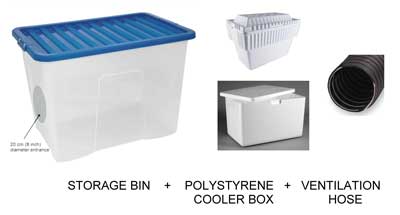Moab is an incredible landscape and being that we are high desert we are a place of extreme temperatures. This winter has been especially cold. Often the first night it gets below freezing each year, I get a full day of questions about how to keep outside cats warm and safe. There are many things to consider in helping our feral cat population stay healthy; ensuring they have daily fresh water to drink, calories to consume that suppliment the tougher hunting months. Also maintaining our trap, spay/neuter program to help control the population. Where most people draw a blank is shelter. So here is an excellent, economical way to help those ferals stay warm at night.

 List of materials: List of materials:
- 1 large container with lid (20 to 30 gallon container)
- 1 med/small container with lid (10 to 15 gallon
container)
- 1 roll of duct tape
- 1 utility knife
- Ventilation hose or empty plastic food container (this will be opening for the cat to enter)
- Marker
- Straw (preferred) or non-toxic spray foam or styrafoam boards
Step 1: Line larger container bottom with layer of insulation and place smaller container inside leaving enough room so that the larger container can close over the smaller container.
Step 2: Trace your entryway outline (using the hose or food container) on the outside container and cut-out
Step 3: Trace your entryway on inside container while it’s inside the larger container, so the entryway lines up
 Step 4: Attach the hose or food container from the outside to inside using duct tape (make sure all edges are smooth and covered with duct tape to create a good seal that keeps the cold out) Step 4: Attach the hose or food container from the outside to inside using duct tape (make sure all edges are smooth and covered with duct tape to create a good seal that keeps the cold out)
Step 5: Fill in ALL the air gaps between the outside and inside container with your chosen insulation.
Step 6: Put insulation on the bottom of the inside container as bedding (straw is best, towels or blankets don’t work nearly as well as straw and some fabrics can actually wick warmth away from the animal).
Step 7: Put the lid on the inside container and cover with insulation and finally put the lid on the outside container.
Step 8: When placing this shelter outside make sure to keep it off the ground by at least a few inches.
Tips for success:
Make sure the shelter is not too large, or the animal’s body heat will not be able to keep it warm. Too small and the animal will not be able to get in or turn around. The sizes we provided in the materials list are a happy medium for what is best for a single cat shelter.
Use a mix of insulation materials to get the best seal.
Consider where the wind comes from and make sure to face the entrance away from elements if possible.
Make sure you elevate the shelter and keep it off the ground, this is the most important factor to consider, as the ground will pull all of the heat from the shelter.
Have a dog that lives outside? This exact shelter can be modified to fit an animal of any size, so if the idea of an insulated dog house sounds good just super size our plan! The warmer these animals stay the less calories they have to consume to stay warm. Saving you money and keeping these animals comfortable during these brutally cold nights in the high desert. You can also use a large outside container, and multiple inside containers with multiple entryways to provide housing for more than one animal. Use your imagination, and whatever materials you have available. Just remember to create an insulated gap between the inside and outside layer and elevate to make it warm.
A big thank you to all the people out there that maintain animals in need without homes!! |